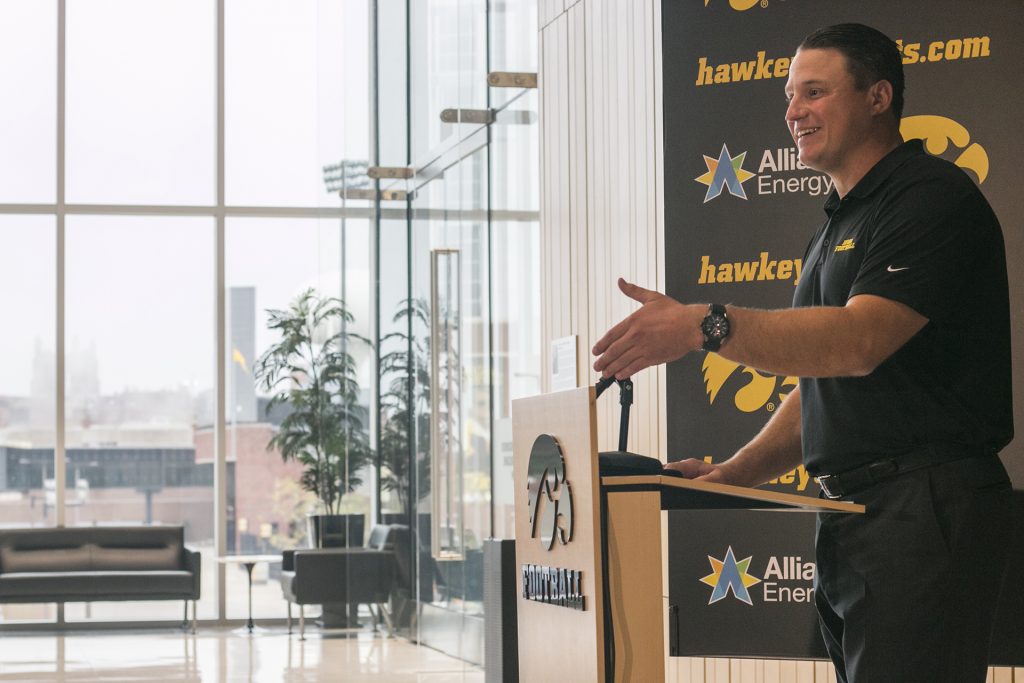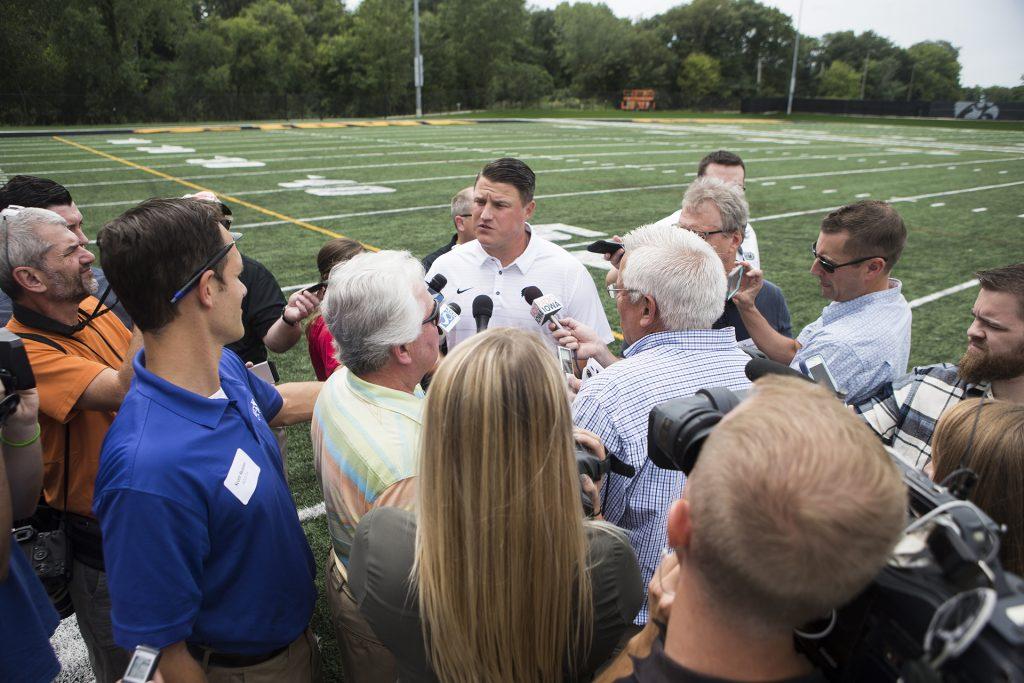By Adam Hensley
[email protected]
Iowa’s loss to Michigan State stands as a game Hawkeye fans would love to forget.
In the 17-10 loss, Iowa’s offense looked lost. The running game was nonexistent, and untimely turnovers suffocated any offensive momentum. The players made it clear: They needed to execute better.
“I think we’ve got to do a better job of bringing our preparation during the week to the game,” offensive lineman Sean Welsh said after the game. “Practicing well during the week and then bringing that same tempo, execution, to the playing field.”
But offensive coordinator Brian Ferentz didn’t blame execution for Iowa’s offensive woes.
He blamed himself.
“I don’t think we had a good plan going into Michigan State running the football, and then unfortunately, our line has got to take the brunt of the criticism,” Ferentz said. “I think that starts with me. I didn’t design it very well. We didn’t have a good plan going in there. We didn’t ask guys to do things that were going to help us be successful, so who’s fault is that? That’s mine. I’ve got to live with that.”
Ferentz is in his first season as Iowa’s offensive coordinator, and he said it himself. He’s still learning. But he’s taking responsibility.
Iowa mustered 226 yards of offense in the loss to Michigan State, including an abysmal 19 yards on 25 rushing attempts — anything but a traditional Hawkeye ground game.
That Michigan State game, Ferentz said, was “as low as it gets.” But he’s had his share of mountain-top moments as well.

The Hawkeyes’ offense looked unstoppable at times in the win against Iowa State on Sept. 9. In the high-scoring, back-and-forth affair, Iowa put up 497 yards of offense, but the passing game — something that hasn’t always been a strength for the Hawkeyes, especially in the last few seasons — proved to be relentless.
Quarterback Nate Stanley churned out a 333-yard, 5-touchdown performance in the overtime win. Akrum Wadley rushed for 118 yards and a touchdown, and James Butler had 37 yards on the ground, too. The two backs combined for 153 yards from scrimmage and 2 touchdowns. It was an offensive performance in which the Hawkeyes completely tore apart the Cyclone defense.
RELATED: Hawkeyes top Cyclones in overtime classic
But recently, the offense hasn’t been there.
Ferentz said he doesn’t dwell on his success as a play caller, because he doesn’t think there has been that much success so far this season on his part. The success has come from players and the rest of Iowa’s coaching staff.
He’s more focused on the things he hasn’t done well, and one particular play sticks with Ferentz.
Backed up inside their own 5-yard line against Penn State, the Hawkeyes elected to run a toss to Wadley, who was tackled in the end zone for a safety. In that situation, Iowa could have elected to play it safe and run inside, rather than tossing a ball behind the line of scrimmage and outside the tackles — it was a risky call, with the Nitany Lions stacking the box.
Play-calling success doesn’t come overnight. Ferentz knows that he constantly needs to be critiquing and tweaking his schemes.
“The minute you think you have it figured out, the minute you think you’re any good at anything … that’s when somebody is sneaking up to get you because we never have it figured out,” he said.
One of the big adjustments to the Iowa offense is how the Hawkeyes line up pre-snap.
Iowa’s used some two-tight-end schemes, but Ferentz doesn’t necessarily use them in their traditional positions.
RELATED: Iowa wins first game of season, tops Wyoming, 24-3
Ferentz’s new offense features Noah Fant, a 6-5, 232-pound tight end, as a hybrid — essentially giving the Hawkeyes a third receiving target aside from two wide receivers.
His versatility, something Iowa did not use very much last season, gives Ferentz the ability to mix things up with personnel and formations.
On various occasions, Iowa has lined up Fant in the backfield while in the shotgun formation. Sometimes, he’s stayed there, other times he’s gone in motion out. Ferentz has even ran tight-end sweeps with Fant, as in the season-opener against Wyoming.
Granted, that play lost 4 yards, but it was a different look in the play caller’s first game.
“When you go into the first game and you’ve never done it before, you wonder if anything you call is going to be successful,” Ferentz said. “You might be the first play caller in history to not make a first down in 12 games.”
On Iowa’s first three drives in the opener, the Hawkeyes failed to get a first down. The offensive coordinator’s worries faded, however, as Iowa registered its first first down of the season at the four-minute mark in the first quarter.
Ferentz’s offense in his first game as Iowa’s play caller ended up being inconsistent, and that’s been a theme that has followed the Hawkeyes throughout the season.
Despite Iowa’s search for offensive consistency, the Hawkeyes have had chances to win every game they’ve been in this year.
It’s a matter of implementing and following through with the game plan, something Ferentz is well aware of. While he’s frustrated and disappointed, he’s certainly not discouraged.
The running game, Iowa’s bread and butter, hasn’t been there this season — at least compared with traditional standards.

Former offensive coordinator Greg Davis drew heavy criticism for his offensive style, but Iowa averaged 4.5 yards per rushing attempt in 2015 and 2016.
The Hawkeyes sit at 3.5 yards per carry, the lowest totals since averaging 3.3 in 2009.
Ferentz said he approaches the running issues situationally, not by looking at efficiency as one would with third downs.
Yards per carry is a fair estimate of a team’s success, he said, and he believes Iowa’s ground game will balance out over time.
“There have been some years we’ve run the ball better, and other years we’ve been pretty successful throwing it,” head coach Kirk Ferentz said. “But ultimately, we want to do both efficiently. And to that point, we’re not running the ball right now effectively enough to be where we want to be.”
After Iowa’s 17-10 overtime loss against Northwestern on Oct. 21, Kirk Ferentz made it clear: Iowa will continue to pound the ball on the ground. It seems like common sense, but the head man put it bluntly after the loss: Iowa is a better football team when it can run the ball efficiently.
A consistent rushing attack keeps defenses honest, making things easier for Stanley, a young signal caller.
Iowa’s goal remains to rush at 5-yards a carry, Brian Ferentz said — 1.5 yards better than what the Hawkeyes have done so far.
Granted, he isn’t working with a veteran offense.
Aside from Wadley and Matt VandeBerg, Iowa lacks seasoned play at its skill positions. Tim Polasek, Iowa’s offensive-line coach, is in his first year at Iowa after having been the offensive coordinator at North Dakota State. Kelton Copeland, the first-year wide-receiver coach, had to build a receiving corps from scratch, essentially.
It is possible to add injuries into the equation, but Brian Ferentz isn’t taking those excuses or any others that Iowa fans might throw out there. The potential is there, and it flashed itself against Iowa State and Illinois.
Brian Ferentz knows he’s working with a young offense, and he’s faced with the task of trying to help his unit grow at the same time he’s developing as an offensive coordinator and play caller.
“I think it’s real easy sometimes as a young player to start feeling like maybe you’ve accomplished something or you have arrived,” Brian Ferentz said. “I think we’re learning as a team. When we think we’re good, we have got a problem. If we just operate as if we’re not, then we have a chance to maybe win a couple football games.”



